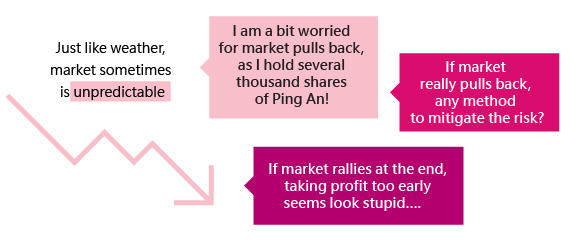Guide for the More Experienced

-
Reasons for hedging against risks
When creating investment portfolios, an investor will have his own views on the future direction of the market, whether it be bullish or bearish. However, the investor cannot foretell the future. Therefore, hedging instruments shall be included in the investment portfolio to reduce the loss arising from having an incorrect view.
For example, an investor is optimistic about a certain stock, but after buying it, he is afraid that the stock price will drop. Therefore, he buys a put warrant at the same time for hedging purposes. The idea for the setup is that, if the stock price rises as he expects, since the warrant’s cost is low, the loss is limited; however, if contrary to expectations the stock price drops, the price of the leveraged warrant rises, which can partially offset the loss caused by the drop in stock price, thus helping to reduce the potential loss.
-
Methods for risk hedging
If an investor wants to use warrants for hedging, how many units of put warrants should he buy to hedge for the underlying assets he holds? The formula is as follow:
The number of units of warrants to be purchased =number of underlying stocks x entitlement ratio of the warrant
deltaFor example, say an investor holds 1,000 AIA shares, and he wants to hedge for the whole investment. Using a 10:1 AIA call warrant with a delta of 40%, the number of units of the warrant needed to be purchased is:
1,000 x 10
0.4= 25,000 unitsNote that when using warrants to hedge for all the stocks held, in theory, the whole investment portfolio may not make a profit whether the stock price goes up or down, because the profit and loss from the stocks and from the warrants will offset against each other. However, in practice, investors will still need to take a view on the future direction of the market, whether optimistic or pessimistic, and use warrants as a hedge for part of the portfolio, in order to reduce the risk of taking an incorrect view.
= number of underlying shares x entitlement ratio of the warrant÷ delta
= 1,000 x 50 ÷ 0.4
= 125,000 units
= number of underlying shares x entitlement ratio of the warrant÷ delta
= 1,000 x 50 ÷ 0.4
= 125,000 units

